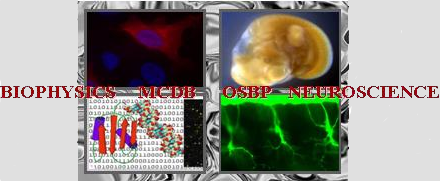Talk abstracts
Talk on Wednesday 03:30-03:45pm submitted by Jonathan Montgomery
Autoinhibition Enhances DNA Scanning Rates in Cre Recombinase
Jonathan S. Montgomery (Ohio State Biochemistry Program), Ehsan Akbari (Department of Physics, The Ohio State University), Michael G. Poirier (Department of Physics, The Ohio State University), Mark P. Foster (Department of Chemistry and Biochemistry, The Ohio State University)
Abstract:
Site-specific DNA recombinases are promising gene editing tools with the ability to manipulate DNA without producing double-strand DNA breaks, as do nuclease-based methods (e.g., Cas9)1. The enzyme Cre (Causes Recombination) has been one of the most widely used DNA recombinases in the study of human health and disease. It selects and recombines DNA at 34 base-pair loxP sequences with high specificity. Its versatility is demonstrated through production of conditional knockout mouse models and targeted insertion of genes through recombinase mediated cassette exchange technologies (RMCE)2. While mutant Cre enzymes have been iteratively engineered to recombine DNA at non-canonical sites, its potential as a therapeutic in human health is hindered by a lack of understanding of the site-selection process.
We have observed that in the absence of DNA, Cre adopts an unexpected autoinhibited conformation in which the C-terminus of the protein docks in cis over the DNA binding interface3. Thermodynamic measurements indicate that this property reduces affinity towards both cognate and noncognate DNA, possibly enhancing the rate of DNA scanning by weakening interactions with DNA4. Using single-molecule fluorescence microscopy in combination with optical trapping, we have measured the rates at which Cre undergoes one-dimensional translocation on long DNA substrates. We found that autoinhibition enhances the rates of DNA scanning by enabling a fast-scanning conformation on noncognate DNA. These findings further our understanding of how Cre locates target sequences in a genomic context and highlights the role of the C-terminus in that process.
References:
1.Foster, M. P., Benedek, M. J., Billings, T. D. & Montgomery, J. S. Dynamics in Cre-loxP site-specific recombination. Current Opinion in Structural Biology 88, 102878 (2024).
2.Meinke, G., Bohm, A., Hauber, J., Pisabarro, M. T. & Buchholz, F. Cre Recombinase and Other Tyrosine Recombinases. Chem. Rev. 116, 12785–12820 (2016).
3.Unnikrishnan, A. et al. DNA binding induces a cis -to- trans switch in Cre recombinase to enable intasome assembly. Proc Natl Acad Sci USA 117, 24849–24858 (2020).
4.Montgomery, J. S., Judson, M. E. & Foster, M. P. Protein and DNA Conformational Changes Contribute to Specificity of Cre Recombinase. Biochemistry (2025)
Keywords: Single-Molecule, Protein-DNA Interactions, Protein Dynamics
